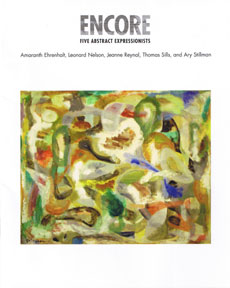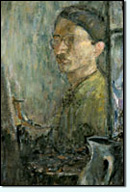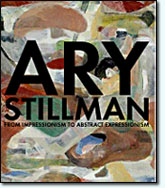Encore: Five Abstract Expressionists:Less Well-Known Figures Emerge, Expanding The Canon at Mishkin Gallery
May 12-June 6, 2006, New York

Ary Stillman's abstract paintings bring together the ordered structure of Cubism and the expressionistic, ritualistic themes that the American Abstract Expressionists inherited from Surrealism. These polarities, successfully reconciled in Stillman's work, reflect his years in Paris as well as his time spent studying Native American and Mexican cultures. Born in 1891 in Hretzk, Byelorussia, Stillman immigrated with his family to Sioux City, Iowa, in 1907. After studying at the Art Institute of Chicago and then at the National Academy of Design and the Art Students League in New York, Stillman moved to Paris. In 1922, he established a studio in Montparnasse and studied with Cubist painter André Lhote.
During his years in Paris, Stillman exhibited regularly in the Paris salons and traveled extensively in Europe, Africa, and the Near East. In 1933, he returned to New York City, where he worked on the Federal Art Project. In 1945, he exhibited his first abstract composition; his show at the Macbeth Gallery in 1946 was entirely non-figurative. Like the work of many other Abstract Expressionists, his abstract work reflected a greater concern with inner reality, mystery, and ritual. Stillman worked in New York until 1955 and in 1957 moved to Cuernavaca, Mexico, where he lived until his failing health forced him to return to the United States. He died in Houston, Texas, in 1967.
In the 1950s and 1960s, Stillman's expressionistic paintings bear titles like Snake Spirit (1960) that reflect his interest in Mayan and Incan civilizations. His heavy impastos and rapid, layered brushwork give his work from this period an evocative, primordial quality. Stillman had also been influenced by the religious dances of Peblo Indians in New Mexico during a visit in 1929, and many of his later abstractions capture the essence of human forms in motion with their stylized, interlocking silhouettes.
Stillman had many solo exhibitions throughout his career, including one in 1928 at Galerie Bernheim-Jeune in Paris. In New York, he had annual shows at the Bertha Schaefer Gallery from 1949 to 1954. He also participated in numerous museum exhibitions, such as the Whitney Museum annuals and exhibitions at the Corcoran Gallery of Art in Washington, D.C., and at the Brooklyn Museum. A retrospective exhibition was organized by the Museum of Fine Arts in Houston in 1972. His work in included in museum collections throughout the United States, including the Museum of Fine Arts, Houston, and the Carnegie Institute Museum of Art, Pittsburgh.
Exhibited Artwork Titles:
Composition with Parakeet, Gold and Blue, Allegretto, Rhythms in Gray, Movement in Space, Untitled, Priscilla, Plaza #6, Plaza #10, Sayville, Parnasse.

c. 1948-1949,
charcoal, pastel and
embossing on paper,
14 x 11 in.,
[Foundation Collection]





